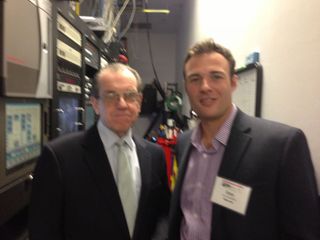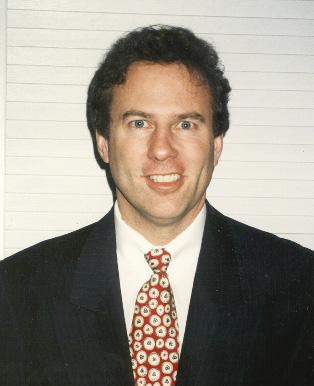CBS’ 'TV City' -- The View Inside A Powerful Eye
For a long time, CBS has been the dominant over-the-air broadcast network, in terms of long-term ratings, long-term profitability, and several other financial metrics. Indeed, even recently, CBS typically dominates the quarter-by-quarter metrics, based upon many pretty good shows, including some like Criminal Minds and CSI: Las Vegas.
Yet there’s some unique irony built into that CSI: Las Vegas scenario.
What is ironic? Well, because much of the popularity and contents testing for that latter show took place in the same place where CSI: Las Vegas takes place, i.e., Nevada’s largest and most recognized city. There is also confusion here, because there appears to be no comparative facility for any of ABC, NBC, Fox or PBS, anywhere I could discover.
And having heard for years about CBS’ “TV City” operation in Las Vegas, this year, I finally ventured forth at CES 2014 this January to see just what “TV City” meant. Indeed, this seemed a perfect time to finally do the standard tour, because my youngest son, Cory-- who entered "the biz” as a business analyst for Technicolor, and now works in sales for Content Distribution Network, Akamai -- was going to be at CES 2014, as well.

A request to CBS brought me quickly and surprisingly efficiently to CBS’ much-respected David Poltrack (pictured with the young Schaeffler at right), who not only designed and implemented TV City for CBS, but has been with the operation for 44 years with CBS, having started at Black Rock as a 24-year-old, in 1969, as manager, marketing services, CBS TV Stations National Sales. Poltrack today serves as CBS chief research officer and the president of CBS Vision, headquartered in New York City, but he services the Nevada unit with frequent visits west.
Poltrack’s full-time associate running the day-to-day operations is vice president Travis Szynski.
Dynamic Data
CBS’ TV City boasts some 35 million visitors a year, which sounds like good numbers for a facility that didn’t begin operations until the beginning of this century, i.e., April 2001, and is thus coming up on its 13th anniversary.
The current daily average of TV City visitors is 14,000/day, and 35 states are typically represented in a standard sample of 225 people.
In addition, a fascinating PowerPoint I received from Szynski offers up these additional data points:
- Over 100,000 People A Week Pass Through the TV City Hallway
- TV City processed 72,276 guests In 2013
- 327 focus groups were conducted in 2013
- 244 one-on-one interviews were conducted In 2013
- 8,786 quantitative sessions were completed In 2013
- Processed 875,048 respondents, from June 2001 through December 2013
Public Power
CBS’ TV City is essentially many thousand square feet of board rooms, theatres, shops, offices, and technical studios, operations, and the like. TV City lies at the end of a long corridor of retail shops at the MGM Grand Hotel and Casino (the MGM is the large green multi-story hotel and casino building, that if looked at from above, resembles a huge cross). Disappointingly, for many out of town visitors, they never even make it to the end of the walkway.
But they should.
It is one of Las Vegas’ best, truly free, visitor activities. And it is one of the few where a public visitor’s opinion actually influences what others see, think, and eventually do.
Indeed, if they decide to accept the free CBS invitation, Las Vegas’ visitors -- without any special qualification or skills (just his/her opinion and choice) -- get to see a lot of new shows before they have even become new shows. And that is fun.
In addition, these public opinion-makers get to actually participate in shows and scenes, in the form of watching them and voting on preferences, etc. Votes often mean “yea or nay” for certain selected video, such as a given program scene, a new pilot show, a new sports anchor, an actor or two, or even a new video game. Indeed, I was told TV City is even working with Google to perfect many Google Glass eyewear applications and “2d screen” applications.
From there, CBS collects and measures and analyzes that data to perfect its product, which is usually a new TV show. CBS’ TV City facility is open 365 days a year, 12 hours daily. In a given year, that is typically 4,380 hours of actual public operation. As noted, access to the facility is also free, and Poltrack and Szynski explain that that is one of the reasons it works so well as a testing ground, i.e., it provides great and easy access to a large and varied demographic, from all over the world, also offering one of the better “free” attractions in Las Vegas . This variety and access, in turn, heightens the effectiveness of the measurements.

Fascinating, too, is the fact that, according to Poltrack, there are 44 facial muscles that involve reactions from all people and all cultures, based upon the viewing of certain content. TV City personnel also spend time measuring their audiences’ heart rates, and can also measure reactions by way of observing the pulsing of people’s blood veins. Who knew?
Another fascinating example Poltrack personally exhibited was a small hand held remote-control like wand that measures how much (or not) a person likes a scene or part of a TV show. This can be especially useful if the audience is asked to make choices, regularly, throughout a program. Encouraged to watch the entire show, many shows end up very well received at their conclusion, but a stagnant part that otherwise might have caused a viewer to switch to another show, is then tweaked (or removed or replaced) by the producers, in order to retain that audience. Much of what CBS does in Las Vegas also involves partnering with Nielsen on various metrics, programs, methods, etc.
Limited Competition?
Half a dozen or so inquiries I made recently indicate that Disney/ABC/ESPN has a research and measurement facility in Austin, Texas. Yet, Poltrack and company are quick to point out that theirs at the MGM Grand is a fully funded, 365-day a year, full-time operation, whereas the competitive ABC facility is funded on a “project-by-project basis,” we were told. No similar facility is believed to exist for NBC, Fox, and PBS. See, for example, http://www.tvtechnology.com/article/nbcuniversal-opens-tech-center-media-lab/223475.
And that’s where I wonder if the success of CBS relative to its longtime over-the-air competitors comes in: TV City and what it does just seems so important to the success of the video CBS deals with, and one can’t help but wonder if CBS having TV City and its competitors not having a similar facility, is the – or at least a strong – reason for CBS’ long-term programming dominance?
Jimmy Schaeffler is a telecom author and chairman and CSO of the Carmel-by-the-Sea-based streaming, broadcast and pay TV/video consultancy, The Carmel Group (www.carmelgroup.com).
Multichannel Newsletter
The smarter way to stay on top of the multichannel video marketplace. Sign up below.
Jimmy Schaeffler is chairman and CSO of The Carmel Group, a nearly three-decades-old west coast-based telecom and entertainment consultancy founded in 1995.

